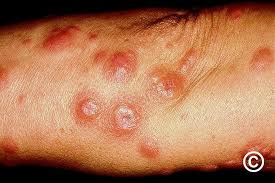 Neutrophilic dermatoses are a group of inflammatory skin conditions characterized by the presence of a sterile neutrophilic infiltrate in the skin.
Neutrophilic dermatoses are a group of inflammatory skin conditions characterized by the presence of a sterile neutrophilic infiltrate in the skin.These conditions present with a variety of clinical skin manifestations, including pustules, bullae, abscesses, papules, nodules, plaques, and ulcers.
Examples:
Sweet syndrome (acute febrile neutrophilic dermatosis)
Characterized by painful erythematous plaques or nodules, often accompanied by fever and leukocytosis.
Pyoderma gangrenosum: Presents as painful, necrotic ulcers with undermined borders, often associated with systemic diseases like inflammatory bowel disease and rheumatoid arthritis.
Subcorneal pustule dermatoses: pustules located in the upper layers of the epidermis, often associated with monoclonal gammopathies.
Behcet’s syndrome-bowelassociated dermatosis-arthritis – syndrome.
Rheumatoid neutrophilic dermatitis.
The pathogenesis of neutrophilic dermatoses involves autoinflammatory mechanisms, with a significant role played by pro-inflammatory cytokines such as interleukin (IL)-1-beta, IL-17, and tumor necrosis factor (TNF)-alpha.
These conditions are often associated with systemic diseases, including hematologic malignancies, inflammatory bowel disease, and autoimmune disorders.
Treatment:
Systemic corticosteroids are the first-line therapy for acute and severe forms, while milder cases may be managed with colchicine, dapsone, or topical corticosteroids.
In refractory cases, biologic agents targeting specific cytokines may be considered.
Unique to neutrophilic dermatosis is pathergy a non-specific inflammatory response to intradermal trauma that manifests as plaques, pustules, papules or ulceration.
